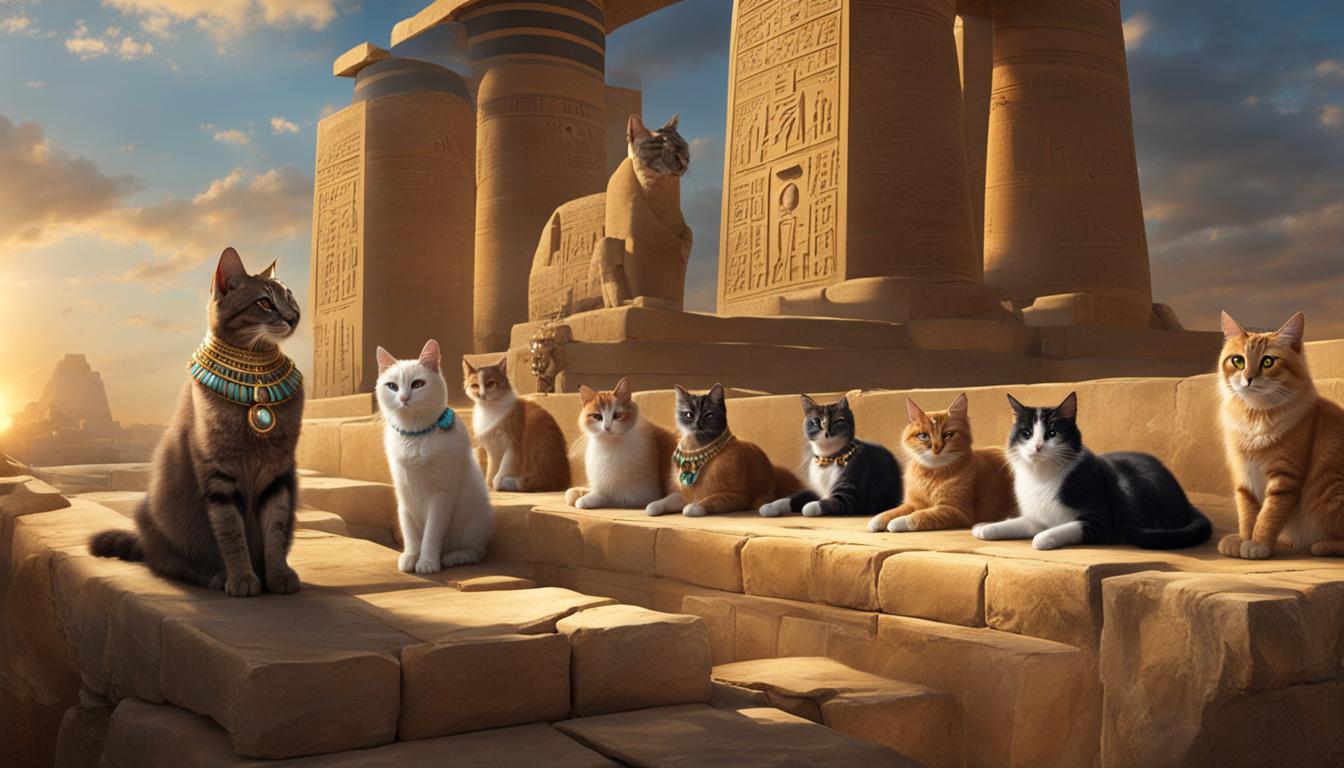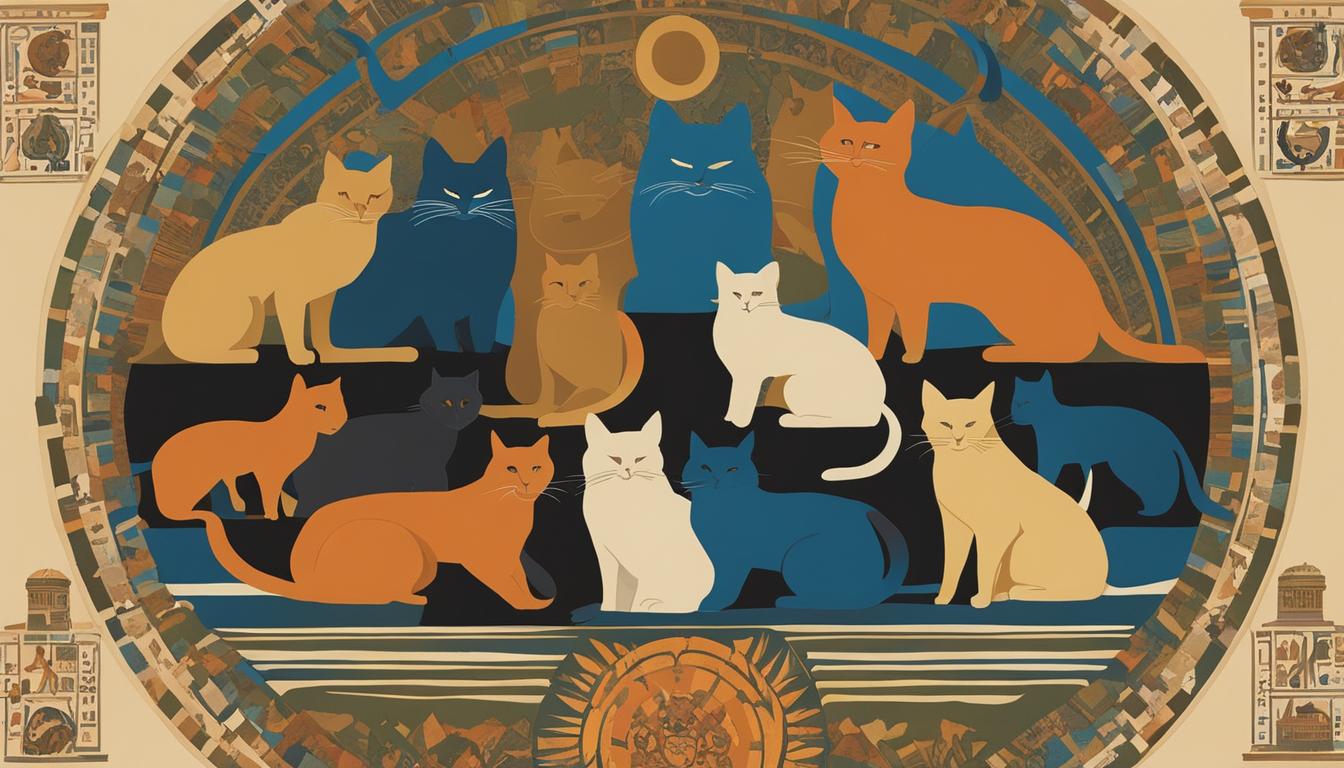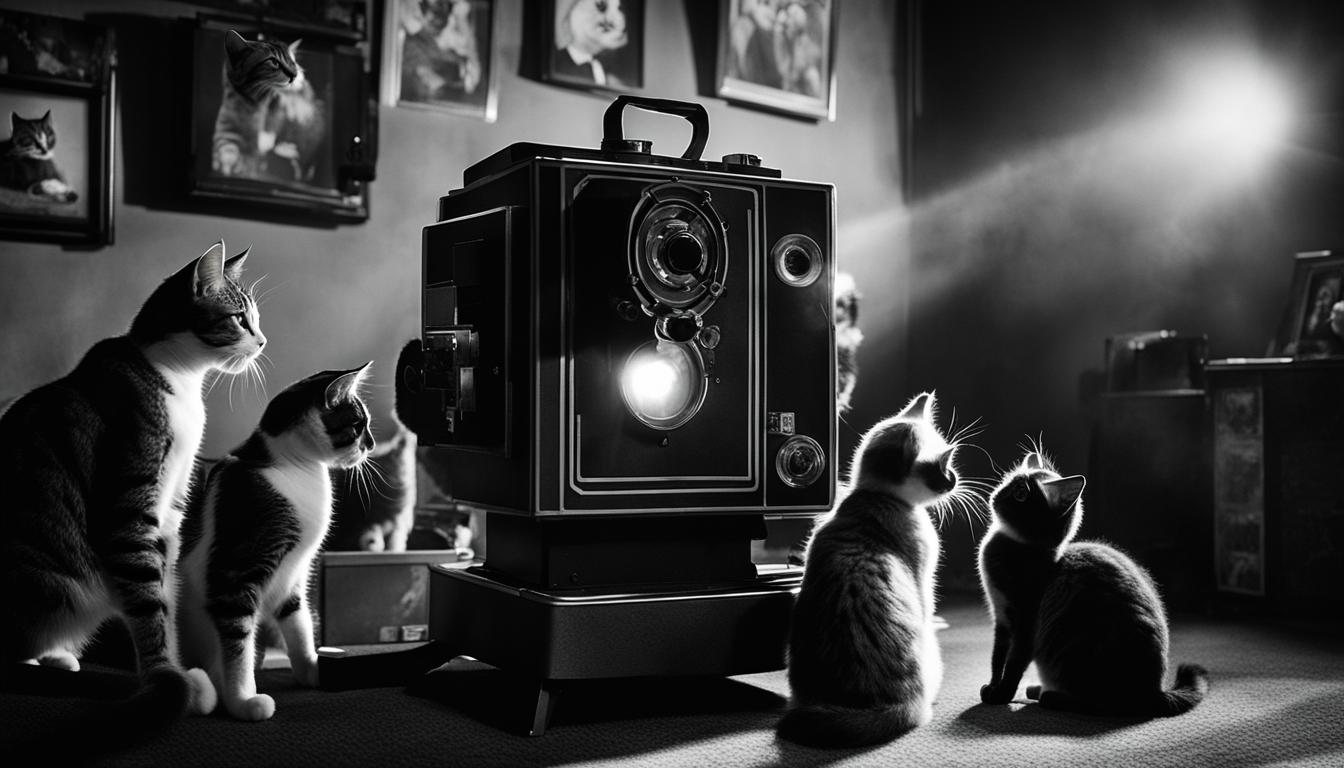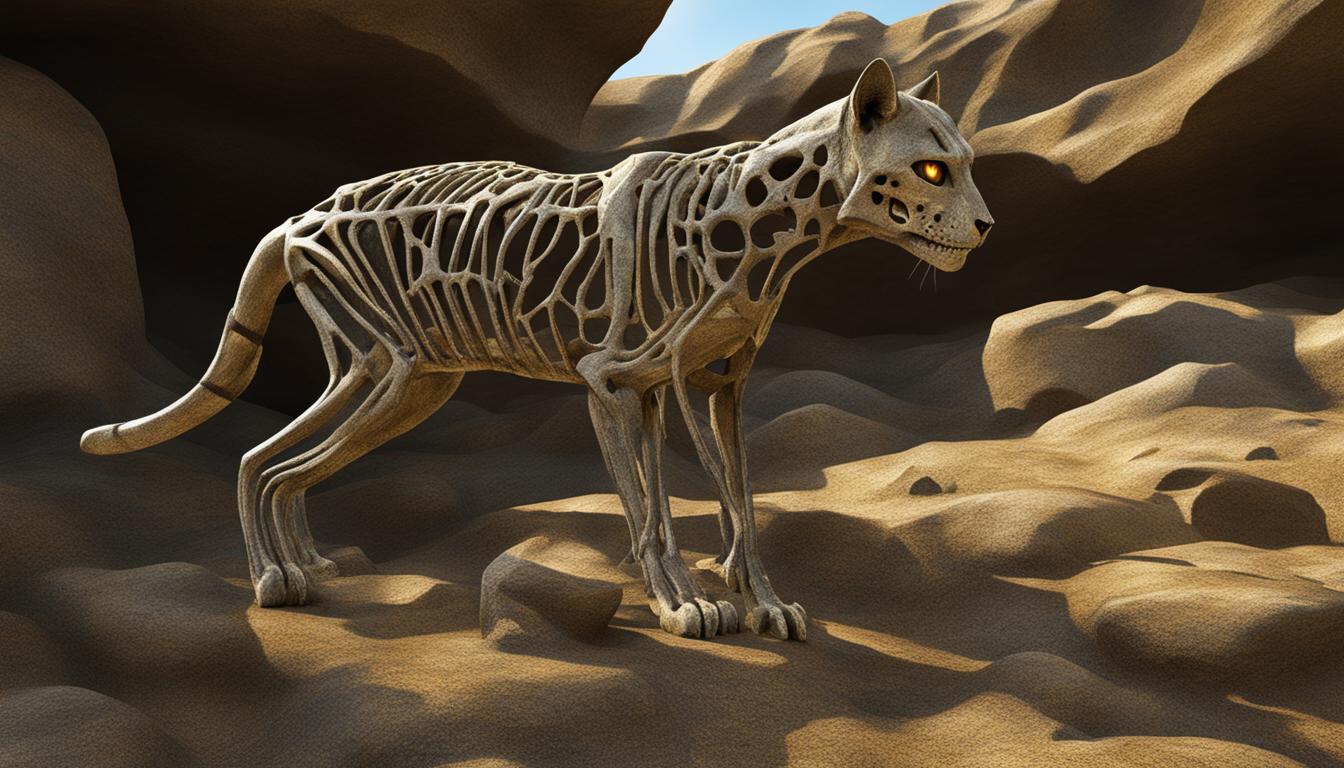Throughout history, cats have played a significant role in various ancient rituals and ceremonies. From ancient Egypt to Japan, cats were revered and worshipped for their unique qualities and abilities. Let’s explore the fascinating history of cats in these ancient rituals and ceremonies.
From their divine status in ancient Egyptian ceremonies to their role as bringers of luck in cultural rituals, cats have left an indelible mark on human history. In ancient rites, these curious creatures held ceremonial roles, symbolizing various aspects of life and spirituality.
Key Takeaways:
- Cats were highly regarded and worshipped in ancient Egyptian ceremonies, playing both practical and spiritual roles.
- Japan’s cultural rituals and historical religious practices embraced cats as symbols of good fortune and prosperity.
- Cats were cherished and valued members of ship crews for their ability to control vermin and boost morale at sea.
- Medieval superstitions associated cats with evil, witchcraft, and malevolent spirits, leading to their persecution.
- Some cruel and inhumane practices involving cats, such as cat-burning rituals, occurred in medieval Europe.
Cats in Ancient Egyptian Ceremonies: A Divine Connection
When exploring the history of cats in ancient rituals and ceremonies, one cannot overlook the profound significance of these enigmatic creatures in ancient Egyptian culture. Cats were not only revered and worshipped as divine beings but also played a practical role in religious rituals.
According to ancient Egyptian beliefs, cats possessed spiritual qualities and were seen as protectors against evil spirits. They were associated with the goddess Bastet, who was often depicted with the head of a lioness or a domestic cat. Bastet symbolized fertility, motherhood, and prosperity, making her worship an integral part of ancient Egyptian religious ceremonies.
“The ancient Egyptians regarded cats as sacred animals and included them in various religious practices. They believed that cats had the ability to connect with the divine and bring good fortune.”
During religious ceremonies, cats were treated with utmost respect and adorned with jewelry and elaborate ceremonial collars. They were often buried alongside their owners as a form of protection in the afterlife. The ritualistic use of cats in ancient Egyptian ceremonies exemplifies the deep reverence and spiritual connection between cats and the ancient Egyptians.
| Role of Cats in Ancient Egyptian Ceremonies | Details |
|---|---|
| Ceremonial Guardians | Cats protected grain stores from rodents and homes from snakes, ensuring prosperity and safety during religious rites. |
| Symbols of Divinity | Cats were associated with the goddess Bastet and were integral to her worship, representing her nurturing and protective qualities. |
| Ceremonial Adornments | Cats were adorned with jewelry and ceremonial collars during religious ceremonies as a sign of their divine status. |
| Afterlife Guardians | Many cats were buried alongside their owners to protect and accompany them in the afterlife, showcasing the spiritual bond between humans and cats. |
Through their symbolic representation and practical role in ancient Egyptian ceremonies, cats left an indelible mark on the religious and cultural practices of this extraordinary civilization. The reverence for cats as divine beings and their involvement in rituals further highlights the unique and enduring connection between humans and these enigmatic creatures.
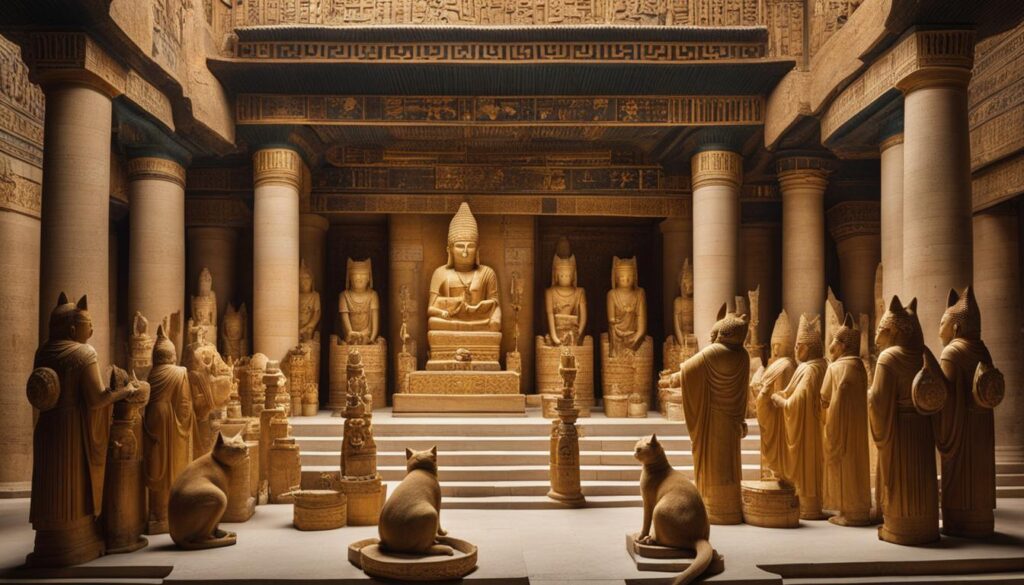
The Rise of Bastet
When delving into the history of cats in ancient rituals, it is impossible to ignore the rise of Bastet, one of the most revered goddesses in ancient Egypt. Bastet, often depicted with the head of a lioness or a domestic cat, held a significant place in pagan rituals and spiritual ceremonies.
Bastet was associated with various aspects of life, including fertility, motherhood, and prosperity. As a nurturing goddess, she was believed to bring abundance and good fortune to those who worshipped her. Cats, being closely associated with Bastet, became an integral part of these rituals, symbolizing the qualities and blessings bestowed by the goddess.
“The inclusion of cats in pagan rituals was deeply ingrained in ancient Egyptian culture.”
The ancient Egyptians believed that cats possessed protective qualities and had the ability to ward off evil spirits. It was common to see cats participating in religious ceremonies, their presence believed to bring spiritual purification and divine intervention. From temple rituals to domestic ceremonies, cats played a vital role in connecting humans with the spiritual realm.
Exemplary Cat Rituals in Ancient Egyptian Culture
Ancient Egyptian rituals involving cats were diverse and fascinating. Let’s explore three notable rituals:
- The Festival of Bastet: This annual festival celebrated Bastet and her feline companions. It involved processions, music, dance, and offerings to the goddess. Cats were adorned with jewelry and treated as honored guests during the festivities.
- Cat Mummification: Cats held such importance in Egyptian society that they were often mummified upon their death. These mummified cats were then offered as votive gifts to Bastet, placed in her temples as tokens of devotion.
- Cat Burials: When a beloved pet cat passed away, it was given an elaborate burial. These burials showcased the deep bond between humans and cats, serving as a testament to the reverence in which they were held.
Through these rituals, the ancient Egyptians celebrated the sacred connection between humans and cats, demonstrating their belief in the spiritual significance of these mesmerizing creatures.
| Ritual | Description |
|---|---|
| The Festival of Bastet | An annual celebration of the goddess Bastet, involving processions, music, dance, and offerings to the deity. Cats were adorned with jewelry and treated as honored guests. |
| Cat Mummification | Cats were mummified upon their death and offered as votive gifts to Bastet. These mummified cats were placed in her temples as tokens of devotion. |
| Cat Burials | Beloved pet cats received elaborate burials, reflecting the deep bond between humans and these revered creatures. |
These rituals, along with numerous others, reinforced the cultural significance of cats in ancient Egyptian ceremonies. The belief in the divine nature of cats and their ability to connect humans with the spiritual realm shaped the fabric of Egyptian society and further solidified the special place cats hold in our history.
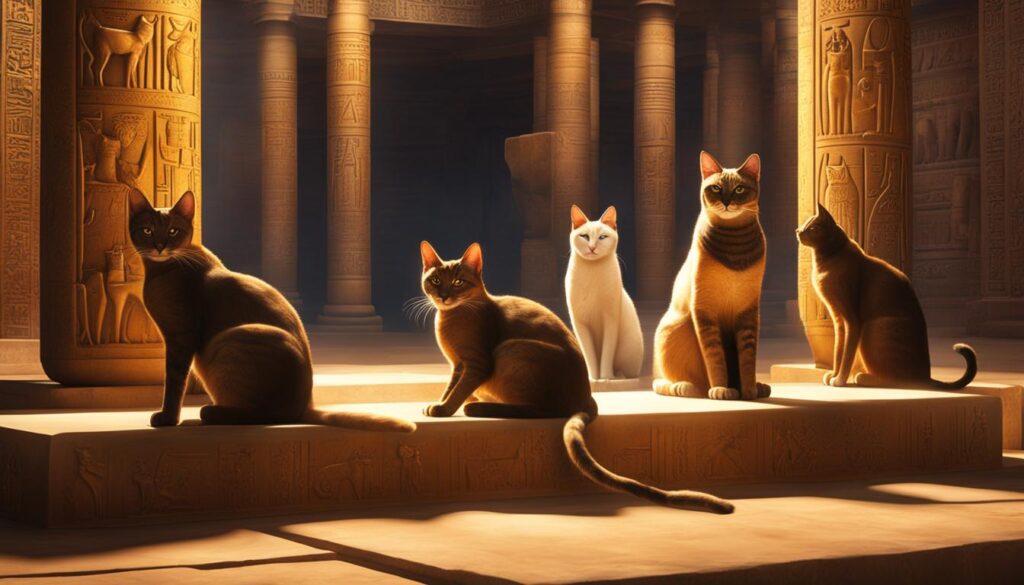
A Glimpse into Japanese Cultural Rituals with Cats
When exploring the rich tapestry of ancient rituals and ceremonies involving cats, it is essential to delve into the fascinating world of Japanese culture. Cats have been deeply ingrained in Japanese traditions for centuries, with a multitude of beliefs and practices that highlight their significance. From charming superstitions to elaborate ceremonies, the cultural rituals surrounding cats in Japan provide a unique window into their revered status.
A Cat’s Role in Bringing Good Fortune
Japanese culture has long believed in the inherent luck and good fortune that cats bring. One of the most iconic symbols of this belief is the Maneki-neko, or the “beckoning cat.” This talismanic figure can be found in stores, homes, and businesses throughout Japan, characterized by a cat with one paw raised in a beckoning gesture. It is believed that the Maneki-neko attracts wealth, prosperity, and good luck to its owner. The raising of its paw signifies the beckoning of wealth and good fortune into one’s life. Whether made of ceramic, porcelain, or even as a small figurine, the Maneki-neko stands as a ubiquitous symbol of the cultural rituals associated with cats in Japan.
The Cultural Significance of the Cat in Japan
Aside from the Maneki-neko, cats have a revered place in the cultural fabric of Japan. They are often depicted in artwork, literature, and even folklore. Cats are viewed as protectors against evil spirits and are believed to have the ability to ward off misfortune. Their presence is considered soothing and helps create a harmonious atmosphere in homes and public spaces. Japanese cat cafes, where patrons can enjoy the company of cats while sipping tea or coffee, are a testament to the cultural significance of these beloved creatures.
In addition to their superstitions and symbolic value, cats have also influenced the traditional Japanese performing arts. The Noh theater, a highly stylized form of drama that dates back to the 14th century, sometimes features the character of a cat. Cats are portrayed as mischievous and mystical, adding an air of intrigue to these traditional performances.
Overall, the cultural rituals in Japan regarding cats highlight the deep-rooted appreciation and reverence for these enigmatic creatures. From beckoning good fortune to protective guardianship against evil, cats have become an integral part of Japanese customs and traditions.
| Table: Cats in Japanese Cultural Rituals | |
|---|---|
| Japanese Cultural Ritual | Significance |
| Maneki-neko (Beckoning Cat) | Brings good fortune and prosperity |
| Cat Cafes | Provides a soothing environment and promotes harmony |
| Cats in Noh Theater | Portrayed as mischievous and mystical characters, adding intrigue to traditional performances |
As we immerse ourselves in the rich history of cats’ influence on cultural rituals, we find that Japan provides a captivating glimpse into their revered status. From their association with good fortune and prosperity to their portrayal in art and theater, cats have left an indelible mark on Japanese culture that continues to be celebrated to this day.
Cats at Sea
When we think of cats, the image of a regal feline basking in the sun or playing with a ball of yarn often comes to mind. However, cats have also made their mark on the high seas, becoming an integral part of maritime history. These furry companions have served aboard ships, bringing joy, companionship, and even luck to sailors.
Throughout history, cats have been valued members of ship crews for their exceptional hunting skills. Vermin such as rats and mice were common stowaways on ships, posing a threat to food supplies and the overall hygiene of the vessel. Cats, with their keen senses and agility, were instrumental in keeping these unwanted pests at bay.
“A ship without a cat is like a ship without a soul.” – Frank Thomas
Cats on ships became a common sight, often earning the title of ship mascots. These feline companions not only provided practical benefits but also helped boost the morale of sailors during long and arduous journeys. The presence of a cat on board was seen as a lucky charm, bringing good fortune and protection from danger.
The Legend of Simon
One notable ship cat was Simon, who served aboard the HMS Amethyst during the Yangtze Incident in 1949. Simon’s presence and unwavering dedication to his duties earned him the respect and admiration of the entire crew. He survived injuries sustained during the conflict and was awarded the Dickin Medal, the highest award for animal bravery in wartime.
| Cat Name | Ship | Achievements |
|---|---|---|
| Simon | HMS Amethyst | Dickin Medal recipient |
| Tiddles | HMS Victorious | Sailed 30,000 miles |
| Oscar | USS Texas | Survived torpedo attack |
Cats on ships continue to be a cherished tradition. Even today, some naval vessels have resident ship cats, carrying on the legacy of their seafaring ancestors. These ship cats bring comfort to the crew and serve as a reminder of the unique bond between humans and animals.
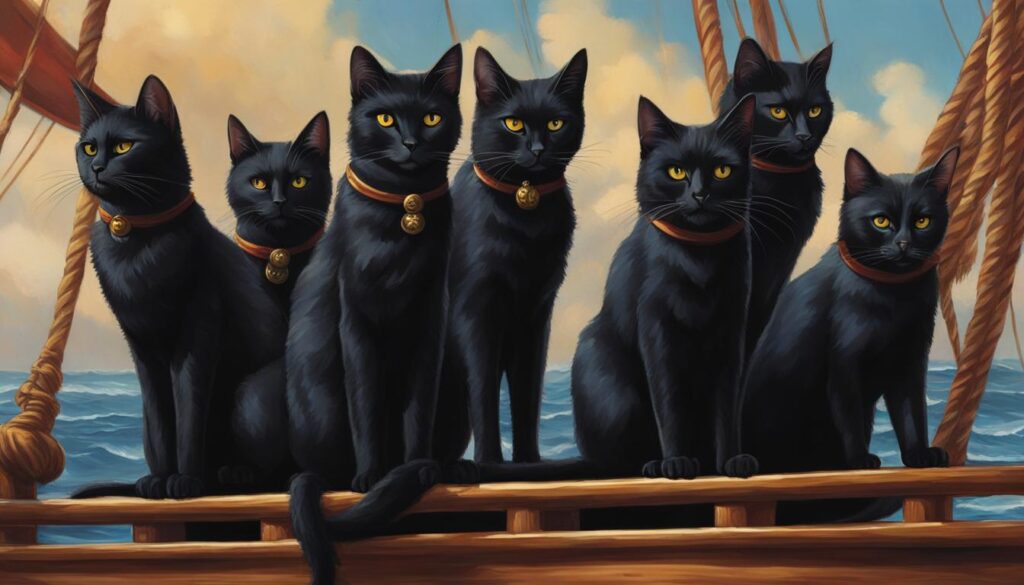
Next time you see a cat lounging in the sun, take a moment to appreciate their historical significance as seafaring companions. From catching rodents to providing companionship and luck, cats on ships have left their pawprints on the annals of maritime history.
Cats in Medieval Superstitions
In medieval Europe, cats were often associated with evil, witchcraft, and superstitions. They were seen as mysterious creatures with supernatural powers, capable of bringing both good fortune and misfortune. The connection between cats and witchcraft was particularly strong, as cats were believed to be the familiars of witches, serving as their companions and assistants in their magical practices.
Cats were also considered omens of both good and bad luck. Crossing paths with a black cat was seen as a sign of impending doom, while seeing a white cat was believed to bring blessings and good fortune. These superstitions led to the persecution and mistreatment of cats, as they were often considered to be in league with the devil.
“The medieval perception of cats as creatures associated with darkness and witchcraft led to widespread fear and mistreatment. Cats were often hunted down and killed during witch trials, as they were believed to be the familiars of witches. This irrational fear and persecution of cats persisted for centuries, staining their reputation and contributing to their association with evil.”
The Evil Associations with Cats
The negative associations with cats in medieval Europe were deeply rooted in ignorance and superstition. The mysterious nature of cats and their solitary behavior made them easy targets for suspicion and fear. People believed that cats possessed supernatural powers and were capable of shape-shifting into witches or demons.
Cat-related superstitions were so ingrained in medieval society that they extended beyond witchcraft. It was believed that if a cat leaped over a corpse, that person’s soul would be possessed by the devil. Cats were also blamed for causing plagues and diseases, as their association with darkness and the supernatural made them convenient scapegoats.
| Evil Associations with Cats | |
|---|---|
| Cats as familiars of witches | Cats possessing supernatural powers |
| Cats as omens of bad luck | Cats as bearers of diseases |

Despite the unjust treatment of cats during this time, their association with evil and witchcraft gradually diminished over the centuries. As society became more enlightened and rational, the superstitions surrounding cats began to fade away. Today, cats are cherished and loved as companions, and their mysterious nature is celebrated rather than feared.
Cat-Burning and Cruel Sports
The dark side of the connection between cats and ancient rituals is evident in the practice of cat-burning and cruel sports during medieval times. In medieval France and other parts of Europe, these horrific rituals and sports involved subjecting cats to unimaginable cruelty for the sake of entertainment and superstition. Cats became victims of inhumane treatment, including being burned alive or beaten in barrels.
The medieval French entertainment industry, in particular, embraced cat-burning as a popular spectacle. This barbaric practice was believed to purge evil omens and malevolent spirits from the community. Cat-burning rituals were often held during festive occasions and public events, adding a chilling twist to what should have been moments of joy and celebration.
Additionally, cat torture sports became a disturbing form of amusement during this era. These sports involved pitting cats against each other in brutal fights, or even setting dogs or other animals upon them. The suffering endured by these innocent creatures was seen as a form of entertainment for the spectators, reflecting a disturbing disregard for animal welfare and ethics.
“The medieval practice of cat-burning and cruel sports reveals a dark chapter in the history of our relationship with these fascinating creatures. It serves as a reminder that our treatment of animals, even in the name of tradition or superstition, should always be guided by compassion and respect.”
The Cruelty of Cat-Burning and Cruel Sports
The cat-burning rituals and cruel sports of medieval times were not only cruel to the cats themselves but also reflected a broader lack of empathy and understanding towards animals. These practices normalized violence towards animals and perpetuated the notion that animals could be subjected to extreme cruelty for human entertainment or superstitious beliefs.
It is essential to understand the historical context in which these practices occurred, but we must also acknowledge the need for progress and compassion in our treatment of animals today. Through increased awareness and education, we can strive for a future where animals are respected and protected from such inhumane practices.
| Practice | Description |
|---|---|
| Cat-Burning Rituals | Involved burning cats alive as a form of entertainment and to ward off evil omens and spirits. |
| Cat Torture Sports | Included pitting cats against each other in fights or setting other animals upon them for spectators’ amusement. |
Conclusion
As I reach the end of my exploration into ancient rituals and ceremonies involving cats, it’s clear to me that these enigmatic creatures have held a remarkable historical significance. From their revered status in ancient Egyptian culture to their roles as ship mascots, cats have left their pawprints on various ancient cultures.
These feline companions were more than just pets; they were symbols of divinity, protectors of homes, and even purgers of evil omens. Cats were deeply ingrained in the fabric of ancient rituals, serving as guardians, beacons of luck, and creatures of myth.
But not all aspects of their involvement were positive. Sadly, cats in medieval Europe were subjected to persecution, tortured, and even burned alive in gruesome rituals. These cruel practices, born from superstitions and misunderstandings, cast a dark shadow on cats’ historical journey.
Nevertheless, the overall cultural importance of cats in ancient rituals cannot be denied. Through their presence in these ceremonies, cats bridged the gap between the physical and spiritual realms, embodying qualities that fascinated and mystified humans throughout history.
FAQ
Were cats worshipped in ancient rituals?
Yes, cats played a significant role in various ancient rituals and ceremonies, particularly in ancient Egypt and Japan.
What was the role of cats in ancient Egyptian ceremonies?
Cats were highly regarded and worshipped as divine beings in ancient Egypt. They played a practical role in society by protecting grain stores from rodents and guarding homes against snakes.
Who was the goddess associated with cats in ancient Egypt?
Bastet, often depicted with the head of a lioness or a domestic cat, was the goddess associated with cats in ancient Egypt. She was worshipped as a nurturing goddess of fertility, motherhood, and prosperity.
How were cats involved in Japanese culture and ceremonies?
In Japan, cats were believed to bring good fortune and luck. They were associated with various superstitions and customs, such as the Maneki-neko or “beckoning cat,” which is believed to bring prosperity to its owner.
How did cats contribute to maritime history?
Cats were valued members of ship crews due to their ability to control vermin and boost morale among sailors. They became mascots and symbols of good luck for many naval forces around the world.
Were cats associated with evil and superstitions in medieval Europe?
Yes, in medieval Europe, cats were often associated with evil, witchcraft, and superstitions. They were seen as symbols of vanity and female sexuality and were persecuted and tortured as they were believed to possess devilish spirits.
What cruel practices were performed on cats in medieval France?
In medieval France and other parts of Europe, cat-burning rituals and cruel sports involving cats were practiced. Cats were subjected to inhumane treatments, such as being burned alive or beaten in barrels, in the name of entertainment and to purge evil omens and malevolent spirits.
What is the overall significance of cats in ancient rituals and ceremonies?
Cats have played a remarkable role in ancient rituals and ceremonies throughout history, from being worshipped in ancient Egypt to being symbols of good luck on ships. Despite some cruel practices, these curious creatures have left their mark on various cultures and societies.

